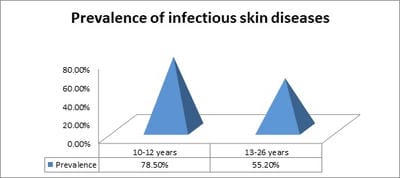Prevalence of skin disease among adolescent girls and their impact on quality of life
Gurram D.1, Kumar K.2*, Pavan I.3, Chary E.4
DOI: https://doi.org/10.17511/ijpr.2021.i02.08
1 Deepika Gurram, Assistant Professor, Department of Pediatrics, Mallareddy Medical College, Hyderabad, Telangana, India.
2* K. Pavan Kumar, Associate Professor, Department of Pediatrics, MNR Medical College, Sangareddy, Telangana, India.
3 Indira Pavan, Consultant Dermatologist, Omega Clinics, Hyderabad, Telangana, India.
4 Eshwara Chary, Professor and Head, Department of Pediatrics, MNR Medical College, Sangareddy, Telangana, India.
Introduction: Skin diseases can adversely affect the quality of life of an individual. Adolescence is a critical time in biophysical development and adverse skin conditions during this period can alter the growth in self-confidence and self-esteem and social engagement. Purpose: The present study was designed to assess the burden, the pattern of skin diseases and their impact on their quality of life in adolescent students. Materials and Methods: A total of 23 schools having 3581 students between 10-16 years of age were visited, out of which 3367 students were covered and screened. Skin characteristics such as the severity of skin disease were recorded by the attended physician. A dermatology life quality index (DLQI) questionnaire was used to assess the effect of skin diseases on their quality of life. Results: Among the total cases 2,783 (82%) had skin diseases, of the 651(19%) had two or more 2 skin diseases. Prevalence of infectious skin diseases was more in (10-12) young age groups 78.5% as compared to (13-16) later age groups of 55.2% (p<0.01). Pediculosis (52%) has a high point of prevalence, followed by scabies (25%), Pityriasis alba (6.6%), Seborrheic dermatitis (5%), Pyoderma (3.3%), Acne (2.6%) and Tinea (2%). Pediculosis and scabies together constitute 77% of all skin diseases. Conclusion: Good hygiene practices like regular bathing, regular head wash, and hand wash should be taught to children. Hence training of school teachers and PHC doctors regarding the management of common skin diseases and Health education to parents or guardians of children about Hygienic measures, sexual behaviour and need of seeking medical advice.
Keywords: Pattern of skin diseases, Dermatology life quality index (DLQI) questionnaire, Quality of life
| Corresponding Author | How to Cite this Article | To Browse |
|---|---|---|
| , Associate Professor, Department of Pediatrics, MNR Medical College, Sangareddy, Telangana, India. Email: |
Gurram D, Kumar KP, Pavan I, Chary E. Prevalence of skin disease among adolescent girls and their impact on quality of life. Pediatric Rev Int J Pediatr Res. 2021;8(2):116-120. Available From https://pediatrics.medresearch.in/index.php/ijpr/article/view/668 |


 ©
© 